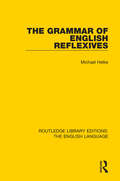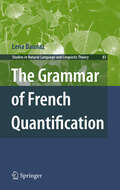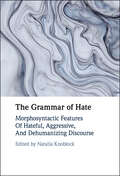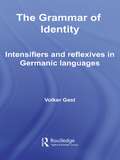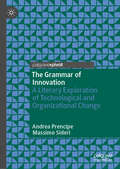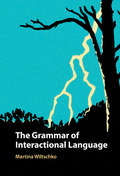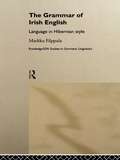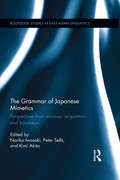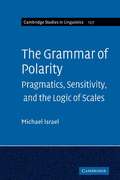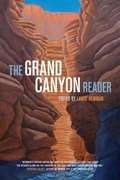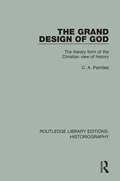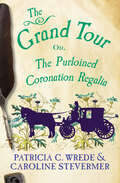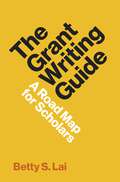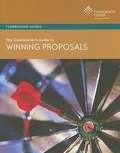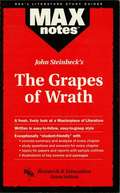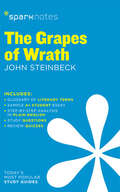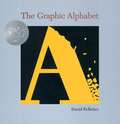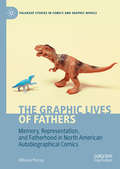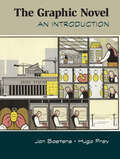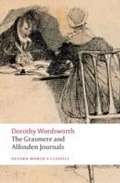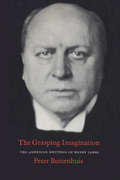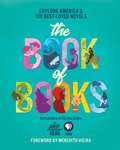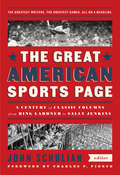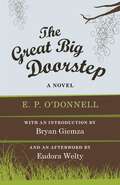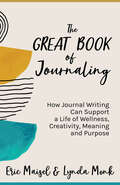- Table View
- List View
The Grammar of English Reflexives (Routledge Library Editions: The English Language #12)
by Michael HelkeThis work, first published in 1979, was a doctoral dissertation submitted to the Department of Foreign Literatures and Linguistics of the Massachusetts Institute of Technology in 1970. The first chapter of this thesis concerns the supposed complementarity of reflexives and ordinary anaphoric pronouns. In the second chapter a theory of reflexivisation is characterised which encompasses several other theories. The third chapter considers apparent counter-examples to the generalizations regarding reflexives that were established in Chapter Two. The fourth chapter concerns the meaning of reflexives. This book will be of interest of students of language and linguistics.
The Grammar of French Quantification
by Lena BaunazThis book is the first extensive study on French Quantification in the field of Syntax. It provides a typology of four main quantified noun phrases in French (existential, universal, negative and wh-), detailing their syntactic, semantic and prosodic behaviors and showing that they can be reduced to two classes--Split-DP structures or Floating quantification. Relying on syntax and semantics, the book establishes a three-way structural typology of wh in-situ phrases and extends it to existentials. It pays special attention to the prosodic properties associated with their different readings and proposes an analysis of the distribution of subextraction and pied-piping. Similarly based on semantic and syntactic tests, the book reveals N(egative) words to be universal Quantifiers. It proposes a new structure of N-words in terms of constituent negation and includes a detailed analysis of the difference between not an N and not all the N in French.
The Grammar of Hate: Morphosyntactic Features of Hateful, Aggressive, and Dehumanizing Discourse
by Natalia KnoblockHate speech continues to be an issue of key social significance, yet while its lexical and discursive aspects have been widely studied, its grammatical traits have been hitherto overlooked. This book seeks to address this gap by bringing together a global team of scholars to explore the morphosyntactic features of hateful and aggressive discourse. Drawing on thirteen diverse cross-linguistic case studies, it reveals how hate is expressed in political discourse, slang, and social media, and towards a range of target groups relating to gender, sexual orientation, and ethnic identity. Based on ideas from functional and cognitive linguistics, each thematic part demonstrates how features such as morphology, word formation, pronoun use, and syntactic structures are manipulated for the purpose of expressing hostility and hate. An innovative approach to an age-old problem, this book is essential reading for researchers and students of hate speech and verbal aggression.
The Grammar of Identity: Intensifiers and Reflexives in Germanic Languages (Routledge Studies in Germanic Linguistics)
by Volker GastEnglish self-forms and related words from other Germanic languages (e.g. Dutch zelf, Swedish själv, etc.) are used in two different functions: as ‘intensifiers’ (e.g. The president himself made the decision) and as markers of reflexivity (John criticized himself). On the basis of a comparative syntactic and semantic analysis, this book addresses the question of why two such apparently different functions can be expressed by the same word. This question is answered by showing that both intensifying and reflexive self-forms can be analysed as expressing the concept of ‘identity’. In the first part of The Grammar of Identity, the most central facts concerning the distribution of intensifiers in Germanic languages are surveyed and a detailed syntactic and semantic analysis is provided. It is shown that all instances of intensifiers can be analysed as expressions of an identity function. The second part of the book offers an analysis of reflexive self-forms which is based on recent theories of reflexivity, modifying these in some important respects. In particular, the distribution of reflexive self-forms is explained with reference to semantic properties of the sentential environment. In this way, it can be shown that reflexive self-forms – like intensifiers – can be analysed as expressions of an identity function. In addition to providing a thorough comparative description of the hitherto poorly described area of intensifiers in Germanic languages, this book offers an answer to a long standing question in descriptive and theoretical linguistics, namely why self-forms are used in two apparently different functions. By combining analytical methods from syntax, lexical semantics and sentence semantics the study moreover contributes to an understanding of the interaction between structure, meaning and context in a central area of lexico-grammar.
The Grammar of Innovation: A Literary Exploration of Technological and Organizational Change
by Andrea Prencipe Massimo SideriIn Six Memos for the Next Millennium, Italo Calvino elaborated on six concepts or memos to offer insights on the ‘shapes of things to come’, which were lightness, rapidity, exactness, visibility, multiplicity and consistency. To do so, the Italian writer embraced an interdisciplinary approach to describe each concept through juxtaposition of its antonyms, heaviness, slowness, indeterminacy, invisibility, uniqueness, and inconsistency. Inspired by Calvino’s intuition, this book puts forward the notion of the ‘Calvino Method’ to interpret the inner dynamics of innovation processes. Drawing on literature and cases from the fields of innovation, history of technology, organisation theory and corporate strategy, the book elaborates on each of the six concepts to offer a unique angle to understand innovation as technological, organisational and cultural change that generates value across a variety of domains. The linguistic juxtapositions at the root of the CalvinoMethod forms the framework of The Grammar of Innovation and the tension between opposites, which at first seems insoluble, emerges as the catalyst of future thought. This book will be of great interest to scholars of innovation, strategy, organisation studies, philosophy of business, and all those with an interest in the works of Italo Calvino.
The Grammar of Interactional Language
by Martina WiltschkoTraditional grammar and current theoretical approaches towards modelling grammatical knowledge ignore language in interaction: that is, words such as huh, eh, yup or yessssss. This groundbreaking book addresses this gap by providing the first in-depth overview of approaches towards interactional language across different frameworks and linguistic sub-disciplines. Based on the insights that emerge, a formal framework is developed to discover and compare language in interaction across different languages: the interactional spine hypothesis. Two case-studies are presented: confirmationals (such as eh and huh) and response markers (such as yes and no), both of which show evidence for systematic grammatical knowledge. Assuming that language in interaction is regulated by grammatical knowledge sheds new light on old questions concerning the relation between language and thought and the relation between language and communication. It is essential reading for anyone interested in the relation between language, cognition and social interaction.
The Grammar of Irish English: Language in Hibernian Style (Routledge Studies in Germanic Linguistics)
by Markku FilppulaIrish English, also termed 'Anglo-Irish' or 'Hiberno-English', as in this book, is not usually perceived as having a grammatical system of its own. Markku Filppula here challenges this misconception and offers a descriptive and contact-linguistic account of the grammar of Hiberno-English. Drawing on a wide range of authentic materials documenting Hiberno-English dialects past and present Filppula examines: * the most distinctive grammatical features of these dialects * relationships with earlier and other regional varieties of English * the continuing influence of the Irish language on Hiberno-English * similarities between Hiberno-English and other Celtic-influenced varieties of English spoken in Scotland and Wales The Grammar of Irish English is a comprehensive empirical study which will be an essential reference for scholars of Hiberno-English and of value to all those working in the field of Germanic linguistics.
The Grammar of Japanese Mimetics: Perspectives from structure, acquisition, and translation (Routledge Studies in East Asian Linguistics)
by Noriko Iwasaki Peter Sells Kimi AkitaMimetic words, also known as ‘sound-symbolic words’, ‘ideophones’ or more popularly as ‘onomatopoeia’, constitute an important subset of the Japanese lexicon; we find them as well in the lexicons of other Asian languages and sub-Saharan African languages. Mimetics play a central role in Japanese grammar and feature in children’s early utterances. However, this class of words is not considered as important in English and other European languages. This book aims to bridge the gap between the extensive research on Japanese mimetics and its availability to an international audience, and also to provide a better understanding of grammatical and structural aspects of sound-symbolic words from a Japanese perspective. Through the accounts of mimetics from the perspectives of morpho-syntax, semantics, language development and translation of mimetic words, linguists and students alike would find this book particularly valuable.
The Grammar of Polarity
by Michael IsraelMany languages include constructions which are sensitive to the expression of polarity: that is, negative polarity items, which cannot occur in affirmative clauses, and positive polarity items, which cannot occur in negatives. The phenomenon of polarity sensitivity has been an important source of evidence for theories about the mental architecture of grammar over the last fifty years, and to many the oddly dysfunctional sensitivities of polarity items have seemed to support a view of grammar as an encapsulated mental module fundamentally unrelated to other aspects of human cognition or communicative behavior. This book draws on insights from cognitive/functional linguistics and formal semantics to argue that, on the contrary, the grammar of sensitivity is grounded in a very general human cognitive ability to form categories and draw inferences based on scalar alternatives, and in the ways this ability is deployed for rhetorical effects in ordinary interpersonal communication.
The Grand Canyon Reader
by Lance NewmanThis superb anthology brings together some of the most powerful and compelling writing about the Grand Canyon--stories, essays, and poems written across five centuries by people inhabiting, surviving, and attempting to understand what one explorer called the "Great Unknown." The Grand Canyon Reader includes traditional stories from native tribes, reports by explorers, journals by early tourists, and contemporary essays and stories by such beloved writers as John McPhee, Ann Zwinger, Edward Abbey, Terry Tempest Williams, Barry Lopez, Linda Hogan, and Craig Childs. Lively tales written by unschooled river runners, unabashedly popular fiction, and memoirs stand alongside finely crafted literary works to represent full range of human experience in this wild, daunting, and inspiring landscape.
The Grand Design of God: The Literary Form of the Christian View of History (Routledge Library Editions: Historiography)
by C. A. PatridesThis book, originally published in 1972, offers a stimulating account of the Christian tradition of historiography as it is reflected in works of literature and history. The discussion ranges from the pre-Christian The Iliad up to the 1970s. The author considers subjects such as the Mystery Plays in the medieval synthesis, the nature of the evidence provided by the Renaissance authors in England and the Continent, the contemporary world. The book examines the attitudes of historians and at the use historians have made of the Christian view of history.
The Grand Tour: Or, The Purloined Coronation Regalia (The Cecelia and Kate Novels #2)
by Patricia C. Wrede Caroline StevermerTwo young Regency ladies with special powers must save the monarchy: &“A satisfying blend of magic, mystery, humor, and romance&” (Booklist). Ocean voyages do not agree with wizards, and seasickness during the Channel crossing is the price Cecelia must pay for her budding magical skill. As her nausea ebbs, she is comforted by her new husband, James, and the knowledge that at long last they are on their honeymoon. In their company is Cecelia&’s cousin Kate, newly minted as the Marchioness of Schofield, and her husband, Thomas. The shared journey guarantees the two couples a happy start to married life, if they can survive the perils of the Continent. In Calais, a mysterious woman visits Cecelia with a package intended for Thomas&’s mother. Inside is an alabaster flask of noble manufacture, one of the royal artifacts that have been vanishing all over Europe as part of a magical plot against the French crown. This is no simple honeymoon: On their tour of Europe, Kate and Cecelia must save the monarchy from an emperor-in-exile named Napoleon. This ebook features illustrated biographies of Patricia C. Wrede and Caroline Stevermer including rare photos and never-before-seen documents from the authors&’ personal collections.
The Grant Writing Guide: A Road Map for Scholars (Skills for Scholars)
by Betty LaiA practical guide to effective grant writing for researchers at all stages of their academic careersGrant funding can be a major determinant of promotion and tenure at colleges and universities, yet many scholars receive no training in the crucial skill of grant writing. The Grant Writing Guide is an essential handbook for writing research grants, providing actionable strategies for professionals in every phase of their careers, from PhD students to seasoned researchers.This easy-to-use guide features writing samples, examples of how researchers use skills, helpful tips, and exercises. Drawing on interviews with scores of grant writers, program officers, researchers, administrators, and writers, it lays out best practices, common questions, and pitfalls to avoid. Betty Lai focuses on skills that are universal to all grant writers, not just specific skills for one type of grant or funder. She explains how to craft phenomenal pitches and align them with your values, structure timelines and drafts, communicate clearly in prose and images, solicit feedback to strengthen your proposals, and much more.Ideal for course use, The Grant Writing Guide is an indispensable road map to writing fundable grants. This incisive book walks you through every step along the way, from generating ideas to finding the right funder, determining which grants help you create the career you want, and writing in a way that excites reviewers and funders.
The Grantseeker's Guide to Winning Proposals
by Judith B. Margolin Elan K. DimaioPublished for development officers, nonprofit board members, fundraising consultants, and others in pursuit of grants from U.S. foundations, this guide provides real-world proposals that resulted in funding for a variety of needs, including general operating support, program development, staff salaries, and program evaluation. The featured proposals request anywhere from $5,000 to $500,000 in funding and were approved by international grantmakers such as the Charles Stewart Mott Foundation, large regional funders such as the Robert W. Woodruff Foundation, corporate donors such as the Mitsubishi Electric America Foundation, and local funders (including family foundations).
The Grapes of Wrath (MAXNotes Literature Guides)
by Lee CusickREA's MAXnotes for John Steinbeck's The Grapes of Wrath MAXnotes offer a fresh look at masterpieces of literature, presented in a lively and interesting fashion. Written by literary experts who currently teach the subject, MAXnotes will enhance your understanding and enjoyment of the work. MAXnotes are designed to stimulate independent thought about the literary work by raising various issues and thought-provoking ideas and questions. MAXnotes cover the essentials of what one should know about each work, including an overall summary, character lists, an explanation and discussion of the plot, the work's historical context, illustrations to convey the mood of the work, and a biography of the author. Each chapter is individually summarized and analyzed, and has study questions and answers.
The Grapes of Wrath SparkNotes Literature Guide (SparkNotes Literature Guide Series #28)
by SparkNotesThe Grapes of Wrath SparkNotes Literature Guide by John Steinbeck Making the reading experience fun! When a paper is due, and dreaded exams loom, here's the lit-crit help students need to succeed! SparkNotes Literature Guides make studying smarter, better, and faster. They provide chapter-by-chapter analysis; explanations of key themes, motifs, and symbols; a review quiz; and essay topics. Lively and accessible, SparkNotes is perfect for late-night studying and paper writing. Includes:An A+ Essay—an actual literary essay written about the Spark-ed book—to show students how a paper should be written.16 pages devoted to writing a literary essay including: a glossary of literary termsStep-by-step tutoring on how to write a literary essayA feature on how not to plagiarize
The Graphic Alphabet
by David PelletierMost alphabet books for pre-readers and early readers set out to make the somewhat abstract idea of letters as clear and as clearly linked to words as possible. In The Graphic Alphabet, graphic designer David Pelletier has created an alphabet book that aims to explore letters for their beauty and complexity as design elements as well as help teach kids how to read. His "A," for example, stands for "avalanche," and with its normally pointed top tumbling down the right diagonal, the letter doesn't just stand for the avalanche, it becomes the word. Pelletier is equally ingenious throughout. And while this might not be the best book to make the concept of letters concrete for youngsters, it will certainly help instill in them a sense of wonder about letters and words. <P><P> Winner of the Caldecott Honor
The Graphic Lives of Fathers: Memory, Representation, and Fatherhood in North American Autobiographical Comics (Palgrave Studies in Comics and Graphic Novels)
by Mihaela PrecupThis book explores the representation of fatherhood in contemporary North American autobiographical comics that depict paternal conduct from the post-war period up to the present. It offers equal space to autobiographical comics penned by daughters who represent their fathers’ complicated and often disappointing behavior, and to works by male cartoonists who depict and usually celebrate their own experiences as fathers. This book asks questions about how the desire to forgive or be forgiven can compromise the authors’ ethics or dictate style, considers the ownership of life stories whose subjects cannot or do not agree to be represented, and investigates the pervasive and complicated effects of dominant masculinities. By close reading these cartoonists’ complex strategies of (self-)representation, this volume also places photography and archival work alongside the problematic legacy of self-deprecation carried on from underground comics, and shows how the vocabulary of graphic narration can work with other media and at the intersection of various genres and modes to produce a valuable scrutiny of contemporary norms of fatherhood.
The Graphic Novel
by Jan Baetens Hugo FreyThe essays collected in this volume were first presented at the international and interdisciplinary conference on the Graphic Novel hosted by the Institute for Cultural Studies (University of Leuven) in 2000. The issues discusses by the conference are twofold. Firstly, that of trauma representation, an issue escaping by definition from any imaginable specific field. Secondly, that of a wide range of topics concerning the concept of "visual narrative," an issue which can only be studied by comparing as many media and practices as possible. The essays of this volume are grouped here in two major parts, their focus depending on either a more general topic or on a very specific graphic author. The first part of the book, "Violence and trauma in the Graphic Novel", opens with a certain number of reflections on the representation of violence in literary and visual graphic novels, and continues with a whole set of close readings of graphic novels by Art Spiegelman (Maus I and II) and Jacques Tardi (whose masterwork "C'?tait la guerre des tranch'es" is still waiting for its complete English translation). The second part of the book presents in the first place a survey of the current graphic novel production, and insists sharply on the great diversity of the range in the various 'continental' traditions (for instance underground 'comix', and feminist comics, high-art graphic novels, critical superheroes-fiction) whose separation is nowadays increasingly difficult to maintain. It continues and ends with a set of theoretical interventions where not only the reciprocal influences of national and international traditions, but also those between genres and media are strongly forwarded, the emphasis being here mainly on problems concerning ways of looking and positions of spectatorship.
The Grasmere and Alfoxden Journals
by Dorothy Wordsworth Pamela WoofDorothy Wordsworth's journals are a unique record of her life with her brother William, at the time when he was at the height of his poetic powers. Invaluable for the insight they give into the daily life of the poet and his friendship with Coleridge, they are also remarkable for their spontaneity and immediacy, and for the vivid descriptions of people, places, and incidents that inspired some of Wordsworth's best-loved poems. The Grasmere Journal was begun at Dove Cottage in May 1800 and kept for three years. Dorothy notes the walks and the weather, the friends, country neighbors and beggars on the roads; she sets down accounts of the garden, of Wordsworth's marriage, their concern for Coleridge, the composition of poetry. The earlier Alfoxden Journal was written during 1797-8, when the Wordsworths lived near Coleridge in Somerset. Not intended for publication, but to "give Wm Pleasure by it," both journals have a quality recognized by Wordsworth when he wrote of Dorothy that "she gave me eyes, she gave me ears."
The Grasping Imagination: The American Writings of Henry James
by Peter Martinus BuitenhuisThere has been almost no study of the American writings of Henry James, that is, the fiction, essays, and travel literature with an American setting. The great bulk of Jamesian criticism deals with the international novels, particularly his late works.This study places James's career in a new perspective by discussing its American aspect. It gives the critic an opportunity to come to grips with the evolution of James's technique from his second short story to his penultimate, unfinished novel, The Ivory Tower.
The Great American Read: Explore America's 100 Best-Loved Novels
by PbsA blockbuster illustrated book that captures what Americans love to read, The Great American Read: The Book of Books is the gorgeously-produced companion book to PBS's ambitious summer 2018 series. What are America's best-loved novels? PBS will launch The Great American Read series with a 2-hour special in May 2018 revealing America's 100 best-loved novels, determined by a rigorous national survey. Subsequent episodes will air in September and October. Celebrities and everyday Americans will champion their favorite novel and in the finale in late October, America's #1 best-loved novel will be revealed. The Great American Read: The Book of Books will present all 100 novels with fascinating information about each book, author profiles, a snapshot of the novel's social relevance, film or television adaptations, other books and writings by the author, and little-known facts. Also included are themed articles about banned books, the most influential book illustrators, reading recommendations, the best first-lines in literature, and more. Beautifully designed with rare images of the original manuscripts, first-edition covers, rejection letters, and other ephemera, The Great American Read: The Book of Books is a must-have book for all booklovers.
The Great American Sports Page: A Library of America Special Publication
by Charles P. Pierce John SchulianA first-of-its-kind celebration of the newspaper scribes who made sportswriting a glorious popular art, and immortalized America's greatest games and athletesSpanning nearly a century, The Great American Sports Page presents essential columns from more than three dozen masters of the press-box craft. These unforgettable dispatches from World Series, Super Bowls, and title bouts for the ages were written on deadline with passion, spontaneity, humor, and a gift for the memorable phrase. Read avidly day in and day out by a sports-mad public, these columnists became journalistic celebrities in their home cities, their coverage trusted and savored, their opinions hotly debated. Some even helped change the games they wrote about. Gathered here in a groundbreaking anthology, their writings capture some of sport's most enduring moments and many of its all-time greats: Babe Ruth, Jackie Robinson, Muhammad Ali, and Michael Jordan among them. But the best American sportswriters also found ways to write powerfully about lesser-known athletes and to convey, often with heartbreaking honesty and insight, the less glamorous and more tragic facets of the games we love. In its survey of the finest American sportswriting from Ring Lardner to Thomas Boswell, from Red Smith and Jimmy Cannon to Bob Ryan and Michael Wilbon, The Great American Sports Page takes the measure of the human richness, complexity, and competitive spirit of sports and the athletes who continue to fascinate and inspire us.
The Great Big Doorstep: A Novel
by Eudora Welty Bryan Giemza E. P. O'DonnellA Depression-era comic masterpiece, E. P. O'Donnell's The Great Big Doorstep centers on the Crochets, a Cajun family who live in a ramshackle house between the levee and the Mississippi River. The Crochets dream of one day owning a stately plantation befitting the magnificent cypress doorstep they have salvaged from the river and proudly display outside their humble home. The memorable characters in this novel have their own concerns: the patriarch, Commodo, is full of wild bravado as he fluctuates between scheming, laboring, and malingering; his wife reigns as the queen of retort, though toughened by years of making do and doing without. The Crochet children also cope with personal struggles: Topal, twenty, restless, and moody, and recently dumped by her fiancé; Arthur, eighteen, attempts to strike out on his own while dodging the coddling of his mother and the fury of his father; Evvie, almost fifteen, plans to join a religious order after renouncing a lover; and twins Gussie and Paul, and baby T. J., provide an ongoing chorus of laughter and tears. The Great Big Doorstep has remained a literary and cultural classic since its publication in 1941. In an 1979 afterword, Eudora Welty praises O'Donnell's comic genius, citing his "supreme gift" for dialogue, while Bryan Giemza's introduction underscores the work's place in the tradition of comic Southern novels.
The Great Book of Journaling: How Journal Writing Can Support a Life of Wellness, Creativity, Meaning and Purpose
by Eric Maisel Lynda MonkLearn how to quell worry and anxiety and fuel creativity with journaling in this informative guide.From psychotherapist Eric Maisel and Lynda Monk, Director of the International Association for Journal Writing, a guide to journal writing for higher self-esteem. This is the next-generation book on journaling techniques that introduces a younger generation to the immense benefits of journaling and provides all journal writers with the tools they need to grow, heal, and deepen their personal writing experience.Therapeutic journal writing can promote individual healing, creativity, and community-building. The Great Book of Journaling offers multiple perspectives on journaling techniques in an easy-to-use, practical format, along with providing a comprehensive introduction to various techniques and methods for deepening your personal writing.Learn from the best.We’ve rounded up forty of the top journal experts in the world to explain exactly what journal writing can do for you! The Great Book of Journaling is full of practical tips, evidence-based research, and rich anecdotes from their coaching, teaching, therapy work with journal writers, or their personal journal writing.The Great Book of Journaling can help:Create high self-esteem, self-love, and self-confidenceImprove your health and your sense of wellbeingCalm your worry and anxietyServe your creative needsDeepen your personal writingReaders of books on journal writing such as Mindfulness Journal, The Self-Discovery Journal, or No Worries will love The Great Book of Journaling.
